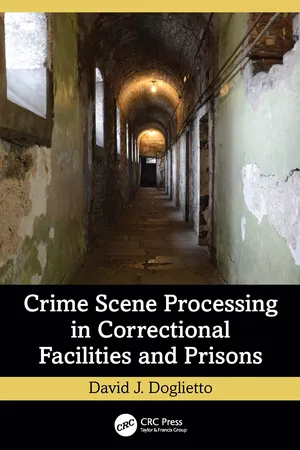
- 328 pages
- English
- ePUB (mobile friendly)
- Available on iOS & Android
Crime Scene Processing in Correctional Facilities and Prisons
About this book
Crime scenes within correctional facilities present investigators with myriad challenges, not only in working, investigating, and collecting evidence but also in obtaining reliable eyewitness accounts. As a result, they are some of the most challenging cases and environments that any investigator will encounter.
Crime Scene Processing in Correctional Facilities and Prisons addresses the unique challenges in prison, correction, and detention facilities, outlining specific procedures and techniques that will reliably improve any investigation. Issues of contaminated crime scenes can result from guards trying to regain order, few to no dedicated staff with no training or understanding of crime scenes, a lack of cooperation from witnesses and victims, and even the lack of cooperation from the on-scene incident commander – whose main objective may be to return the facility to "normal" rather than allow for the proper collection of evidence. Whatever the challenges faced, this book tackles all of them. While the processing of crime scenes entails standard procedures and practices, a correctional setting can provide anything but. As a result, the investigator must be resourceful, tenacious – yet patient – and perform their duties with objectivity and ethical integrity throughout the process.
Features:
-
Serves as the only resource on the market to provide essential investigative and crime scene guidelines unique and specific to correctional facilities
-
Presents the various challenges of gathering and preserving evidence and investigating crimes, in correctional settings – including federal and state prisons, jails, and detention facilities
-
In addition to presenting best practices in handling evidence and investigative procedures, covers unique interview techniques, report writing, and expert testimony
Author David Doglietto, as an experienced professional with decades of first-hand experience, walks readers through the best way to perform duties to cut through the challenges and barriers and avoid the pitfalls that come with the oftentimes complex investigations in these environments. Extensive illustrations and case examples are provided within the book, as chapters present best-practice investigative practices in an environment for which there is little published resource and reference material. Crime Scene Processing in Correctional Facilities and Prisons is an invaluable resource for crime scene investigators, legal professionals, and the staff, leadership, and managers of correctional facilities themselves.
Frequently asked questions
- Essential is ideal for learners and professionals who enjoy exploring a wide range of subjects. Access the Essential Library with 800,000+ trusted titles and best-sellers across business, personal growth, and the humanities. Includes unlimited reading time and Standard Read Aloud voice.
- Complete: Perfect for advanced learners and researchers needing full, unrestricted access. Unlock 1.4M+ books across hundreds of subjects, including academic and specialized titles. The Complete Plan also includes advanced features like Premium Read Aloud and Research Assistant.
Please note we cannot support devices running on iOS 13 and Android 7 or earlier. Learn more about using the app.
Information
Table of contents
- Cover Page
- Half-Title Page
- Title Page
- Copyright Page
- Dedication Page
- Epigraph
- Contents
- Author
- Preface
- 1 The Challenge
- 2 Selecting the Correctional Crime Scene Investigator
- 3 Responsibilities
- 4 Crime Scene Response Classification System & Crime Scene Investigation Inventory
- 5 Crime Scene Processing Methodology & Checklists
- 6 Crime Scene Procedure & Protocol Considerations
- 7 The Role of the Custodial CSI in Escapes, Use of Force, and Shooting Incidents
- 8 Forensic Pathology in the Correctional Setting
- 9 Bloodstain Pattern Evidence in Jails and Prisons
- 10 Suicide Investigations in Jails and Prisons
- 11 Footwear Evidence in Jails and Prisons
- 12 Fingerprint Evidence in Jails and Prison
- 13 Dealing with the Evidence
- 14 Fire Investigations
- 15 Interview Techniques in the Correctional Setting
- 16 Essential Report Writing
- 17 Courtroom Testimony
- 18 The Conclusion
- Glossary
- Index